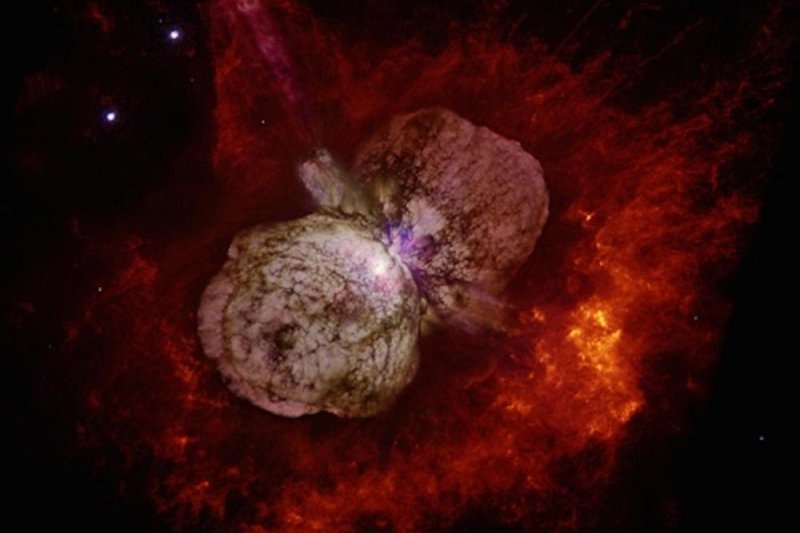Eta Carinae's explosion accelerated massive amount of gas and dust to extremely high speeds. Photo by Hubble/Gemini Observatory
Aug. 2 (UPI) -- New measurements of Eta Carinae suggest the star system produced the fastest non-lethal stellar blast in history.
Though the famed binary star system Eta Carinae exploded 170 years ago, scientists are still able to study the blast by measuring its light echoes. Light echoes are produced by light energy produced by stellar events bounce off and become redirected by distant gas clouds.
Light echoes produced by the massive Eta Carinae -- witnessed by astronomers and laypeople alike during the mid-1800s -- continue to redirect toward Earth, allowing scientists to peer back into the annals of cosmic history.
"A light echo is the next best thing to time travel," Nathan Smith, an astronomer at the University of Arizona, said in a news release. "That's why light echoes are so beautiful. They give us a chance to unravel the mysteries of a rare stellar eruption that was witnessed 170 years ago, but using our modern telescopes and cameras."
The light echoes are helping scientists better understand how the Eta Carinae nebula came to look as it does today. The dumbbell-shaped nebula of gas and dust surrounding the exploded remnant contains more than 10 million times the mass of our sun.
Eta Carinae actually exploded twice in a short of amount time. The smaller eruption set up the system for the second explosion, the "great explosion," which made the star system famous.
"This was a behemoth stellar explosion from a very rare monster star, the likes of which has not happened since in our Milky Way Galaxy," Smith said.
Scientists believe the star system's turbulent stellar winds continue to accelerate particles to extreme speeds. And some of these high-energy cosmic rays likely hit Earth.
Most recently, scientists used a series of telescopes to study Eta Carinae's light echoes and estimate the speeds at which its massive explosion accelerated gas particles.
Scientists measured jettisoned gas speeds between 10,000 and 20,000 kilometers per second.
"We see these really high velocities all the time in supernova explosions where the star is obliterated." Smith said.
But Eta Carinae survived. Researchers believe the eruptive remnant inside the stay system likely didn't act alone. Such a massive eruption would have required the energy of a couple more stars.
Today, Eta Carinae is a binary system, but it may have once been a triple star system. Two of the three stars likely combined into one, triggering a massive explosive event.
Eta Carinae's extreme size and luminosity make it rare -- and important.
"Understanding the dynamics and environment around the largest stars in our galaxy is one of the most difficult areas of astronomy," said researcher Richard Green.
And while Eta Carinae is still active today, it may not be for much longer. Massive, unstable star systems like Eta Carinae live much shorter lives than stars like our sun. Eventually, it will experience a bigger explosion -- a supernova that will spell the end for the binary system.
Astronomers believe massive stars explosions often proceed supernovae, so its possible Eta Carinae produces fireworks sooner rather than later.
The latest analysis of Eta Carinae is scheduled to be published in a pair of papers in the journal Monthly Notices of the Royal Astronomical Society.















